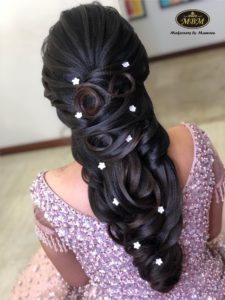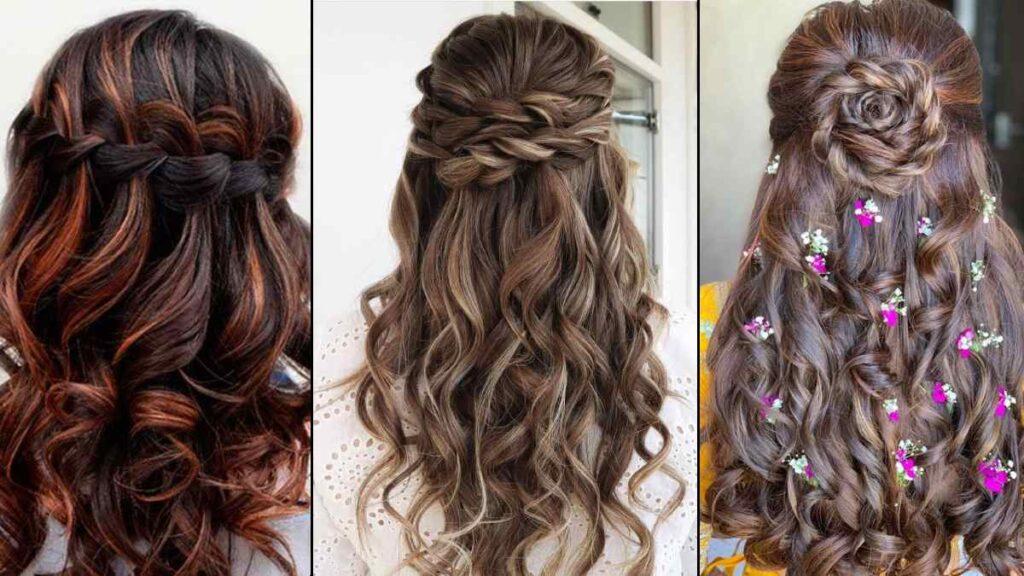Hair stylist course:-
If you’re interested in pursuing a career as a hair stylist, there are several courses and programs you can take to develop the necessary skills and knowledge.
- Cosmetology School: Cosmetology schools offer comprehensive training programs that cover all aspects of hair styling, including cutting, coloring, and styling. These programs typically take anywhere from nine months to two years to complete and may result in a diploma or certificate.
- Apprenticeship: You can also choose to become an apprentice to a professional hair stylist. Apprenticeships typically last for several years and involve hands-on training in a salon or barbershop setting.
- Online Courses: Several online courses are available that teach the fundamentals of hair styling. These courses offer the flexibility to learn at your own pace and from the comfort of your own home.
- Workshops and Seminars: Many professional hair care brands offer workshops and seminars to help stylists improve their skills and learn about the latest trends and techniques.
When choosing a hair stylist course, it’s essential to consider factors such as cost, location, and accreditation. You may also want to research the job market in your area to determine the demand for hair stylists and the salary potential

Hair Stylist Course
If you’re interested in becoming a hair stylist, there are several steps you can take to get started:
- Research hair stylist courses: Look for courses or training programs that offer a comprehensive curriculum in hair styling, cutting, coloring, and other related topics. You can find information on courses online, through beauty schools, or through local salon associations.
- Choose a course: Once you have a list of potential courses, compare the curriculum, length of the program, cost, and any other relevant factors to determine which course is right for you.
- Enroll in the course: Once you have chosen a course, enroll in it and attend classes regularly. Be sure to ask questions, take notes, and practice the techniques you learn.
- Obtain a license: In most states, hair stylists are required to have a license to work in the profession. To obtain a license, you will need to complete a certain number of training hours and pass a written and practical exam.
- Gain experience: After obtaining your license, look for opportunities to gain experience working in a salon or barbershop. This will help you develop your skills, build your clientele, and learn more about the industry.
- Continue your education: To stay up-to-date with the latest trends and techniques in hair styling, continue your education by attending workshops, seminars, and other training programs. This will help you stay competitive in the industry and advance your career.
Prepare self and client Assistant hair stylist course:-
As an assistant hair stylist, it’s essential to not only be prepared for your job but also to help your clients prepare for their appointments. Here are some tips for preparing yourself and your clients:
Preparing Yourself:
- Familiarize yourself with the salon’s products and tools: Make sure you know how to use all the products and tools that your salon uses. This includes blow dryers, flat irons, curling irons, brushes, and combs.
- Practice good hygiene: As a hair stylist, it’s important to maintain good hygiene. Make sure your hair, hands, and clothing are clean before working with clients.
- Be organized: Keep your work area clean and organized. This will help you work efficiently and minimize the risk of accidents.
- Stay up-to-date on trends: Keep up with the latest hair styling trends by reading fashion magazines, attending workshops, and following social media accounts of prominent hairstylists.
Preparing Your Clients:
- Communicate with your clients: Before starting a service, talk to your clients about their desired look, hair type, and any concerns they may have. This will help you provide personalized services.
- Advise clients on preparation: Advise your clients to wash their hair the day before their appointment, avoid using any styling products, and come to the appointment with dry hair.
- Offer suggestions: If your client is unsure of what they want, offer suggestions based on their hair type, face shape, and lifestyle.
- Create a comfortable environment: Make sure your client is comfortable during their appointment by providing a clean and organized work area, offering refreshments, and playing relaxing music.
By following these tips, you can ensure that you are well-prepared for your job as an assistant hair stylist and that your clients are prepared for their appointments as well.

1. use suitable consultation techniques to identify the client’s wishes for the desired look before dressing the hair, including with parents or guardians for minors Consultation techniques: eg. ask questions, catalogue of styles, chart or image referencing, computer aided simula2. ensure a guardian/parent is present for minors under age 14
3. identify and analyse the condition of the hair and its effect on treatment or procedure Assistant hair stylist course.
selection for achievement of the required results
4. select the most suitable drying, setting, styling and finishing techniques to achieve the desired look
5. perform back combing /back brushing technique as required
6. control and secure hair effectively into place, during dressing
7. dress the hair to the satisfaction of the client
8. position self and client to ensure privacy, comfort and safety, throughout the service PC9. perform and adapt the procedure using materials, equipment and techniques correctly and safely to meet the needs of the client
10. apply finishing product following manufacturer’s instructions to maintain the style
11. ensure the finished style takes into account the critical influencing factors Influencing factors: length, density, condition of hair, etc.
12. ask questions to check with the client their satisfaction with the finished result
13. thank customer for feedback post-service, where customer is not satisfied with service take actions to resolve matter to customer satisfaction or refer to supervisor if actions beyond scope of authority or no action is possible to mitigate damage
14. use work methods to minimise wastage
15. dispose waste materials as per organisational standards in a safe and hygienic manner
16. complete the procedure to the satisfaction of the client in a commercially acceptable time and as per organisational standards
17. record details of the procedure accurately as per organisational policy and procedures
18. store information securely in line with the salon’s policies
19. provide specific after-procedure, homecare advice and recommendations for product use and further services to the client
Perform a variety of coloring techniques such as full head, re growth and highlighting and/or lowlighting Assistant hair stylist course:-
As an assistant hair stylist, it’s important to learn a variety of coloring techniques to provide clients with personalized services. Here are some tips for performing full head, re-growth, highlighting, and lowlighting services:
Full Head Coloring:
- Start with clean and dry hair: Make sure your client’s hair is clean and dry before starting the service. This will ensure that the color is applied evenly.
- Mix the color: Follow the instructions on the hair color product to mix the color. Be sure to wear gloves to protect your hands.
- Section the hair: Divide the hair into small sections using clips or rubber bands.
- Apply the color: Starting at the roots, apply the color to each section of hair, working your way down to the ends. Be sure to saturate the hair evenly.
- Process the color: Follow the instructions on the hair color product to determine the processing time. Leave the color on the hair for the recommended time.
- Rinse and condition: After the processing time is complete, rinse the hair thoroughly with warm water. Apply a conditioner to the hair and rinse again.
Re-growth Coloring:
- Section the hair: Divide the hair into small sections using clips or rubber bands.
- Apply the color: Starting at the roots, apply the color to each section of hair, working your way down to the ends. Be sure to saturate the hair evenly.
- Process the color: Follow the instructions on the hair color product to determine the processing time. Leave the color on the hair for the recommended time.
- Rinse and condition: After the processing time is complete, rinse the hair thoroughly with warm water. Apply a conditioner to the hair and rinse again.
Highlighting and Lowlighting:
- Choose the right color: Choose a color that complements your client’s natural hair color and skin tone.
- Section the hair: Divide the hair into small sections using clips or rubber bands.
- Apply the color: Apply the color to small sections of hair using a highlighting or lowlighting technique. Be sure to apply the color evenly and avoid overlapping.
- Process the color: Follow the instructions on the hair color product to determine the processing time. Leave the color on the hair for the recommended time.
- Rinse and condition: After the processing time is complete, rinse the hair thoroughly with warm water. Apply a conditioner to the hair and rinse again.
By following these tips, you can provide clients with personalized full head, re-growth, highlighting, and lowlighting services. It’s important to always follow the instructions on the hair color product and wear gloves to protect your hands during the coloring process.
Create a variety of looks using basic perming techniques Assistant hair stylist course:-
As an assistant hair stylist, it’s important to learn basic perming techniques to provide clients with a variety of looks. Here are some tips for creating different looks using basic perming techniques:
- Choose the right perm rods: Different sizes of perm rods will create different types of curls. Choose the right size based on the desired look.
- Section the hair: Divide the hair into small sections using clips or rubber bands. Make sure each section is evenly sized.
- Apply the perm solution: Follow the instructions on the perm solution to mix and apply it to the hair. Be sure to wear gloves to protect your hands.
- Roll the hair: Starting at the nape of the neck, roll each section of hair onto a perm rod. Secure the rod with a clip.
- Process the perm: Follow the instructions on the perm solution to determine the processing time. Leave the perm solution on the hair for the recommended time.
- Neutralize the perm: After the processing time is complete, rinse the hair thoroughly with warm water. Apply the neutralizer to the hair and leave it on for the recommended time.
- Remove the perm rods: After the neutralizer has processed, remove the perm rods from the hair. Be careful not to tug or pull the hair.
- Style the hair: Style the hair using a blow dryer, diffuser, or curling iron. This will help to enhance the curls and create the desired look.
Some different looks you can create using basic perming techniques include:
- Tight Curls: Use small perm rods to create tight, bouncy curls. This look is great for adding volume to fine hair.
- Loose Waves: Use larger perm rods to create loose, beachy waves. This look is perfect for adding texture and movement to long hair.
- Spiral Curls: Use spiral perm rods to create defined, spiral curls. This look is great for adding drama and interest to short hair.
By learning and practicing basic perming techniques, you can provide clients with a variety of looks and help them achieve the perfect curly or wavy hairstyle.


Perform hair relaxing and straightening services Assistant hair stylist course:-

As an assistant hair stylist, it’s important to learn how to perform hair relaxing and straightening services to provide clients with a variety of styling options. Here are some tips for performing hair relaxing and straightening services:
Hair Relaxing:
- Choose the right product: There are various hair relaxing products available, so choose the right one based on the client’s hair type and desired results.
- Section the hair: Divide the hair into small sections using clips or rubber bands. Make sure each section is evenly sized.
- Apply the relaxer: Follow the instructions on the relaxer product to mix and apply it to the hair. Be sure to wear gloves to protect your hands.
- Process the relaxer: Follow the instructions on the relaxer product to determine the processing time. Leave the relaxer on the hair for the recommended time.
- Rinse and neutralize: After the processing time is complete, rinse the hair thoroughly with warm water. Apply the neutralizing shampoo to the hair and leave it on for the recommended time. Rinse again.
Hair Straightening:
- Choose the right product: There are various hair straightening products available, so choose the right one based on the client’s hair type and desired results.
- Section the hair: Divide the hair into small sections using clips or rubber bands. Make sure each section is evenly sized.
- Apply the straightening product: Follow the instructions on the straightening product to mix and apply it to the hair. Be sure to wear gloves to protect your hands.
- Process the straightener: Follow the instructions on the straightening product to determine the processing time. Leave the straightening product on the hair for the recommended time.
- Rinse and condition: After the processing time is complete, rinse the hair thoroughly with warm water. Apply the conditioner to the hair and leave it on for the recommended time. Rinse again.
It’s important to note that both hair relaxing and straightening can be damaging to the hair, so it’s important to properly assess the client’s hair and make sure it’s healthy enough to undergo the treatment. It’s also important to follow the instructions on the products and not leave them on for longer than recommended.
By learning and practicing hair relaxing and straightening techniques, you can provide clients with a variety of styling options and help them achieve their desired hair texture.
Maintain the health and safety at the workplace:- To be competent, the user/individual on the job must be able to:
set up and position the equipment, chemicals, products and tools in the work area to meet legal, hygiene and safety requirements
clean and sterilize all tools and equipment before use
maintain one’s posture and position to minimize fatigue and the risk of injury
dispose waste materials in accordance to the industry accepted standards
maintain first aid kit and keep oneself updated on the first aid procedures PC6. identify and document potential risks and hazards in the workplace
accurately maintain accident reports
report health and safety risks/ hazards to concerned personnel PC9. use tools, equipment, chemicals and products in accordance with the salon’s guidelines and manufacturers’ instructions
Appearance and behavior:- To be competent, the user/individual on the job must be able to:
1. maintain good health and personal hygiene
2. comply with organisation’s standards of grooming and personal behavior
3. meet the organisation’s standards of courtesy, behavior and efficiency
4. stay free from intoxicants while on duty
5. wear and carry organisation’s uniform and accessories correctly and smartly
Task execution as per organization’s standards:-
To be competent, the user/individual on the job must be able to:
6. take appropriate and approved actions in line with instructions and guidelines
7. record details related to tasks, as per procedure assistant hair course.
8. participate in workplace activities as a part of the larger team
PC9. report to supervisor immediately in case there are any work issues
PC10. use appropriate language, tone and gestures while interacting with clients from different cultural and religious backgrounds, age, disabilities and gender
Communication and Information record Assistant hair stylist course:-
To be competent, the user/individual on the job must be able to:
11. communicate procedure related information to clients based on the sector’s code of practices and organisation’s procedures/ guidelines
12. communicate role related information to stakeholders in a polite manner and resolve queries, if any
13. assist and guide clients to services or products based on their needs
14. report and record instances of aggressive/ unruly behavior and seek assistance
15. use communication equipment (phone, email etc.) as mandated by your organization PC16. carry out routine documentation legibly and accurately in the desired format
17. file routine reports and feedback
18. maintain confidentiality of information, as required, in the role
Core Skills/ Generic Skills:-
The user/ individual on the job needs to know and understand how to:
1. read about new products and services with reference to the organization and also from external forums such as websites and blogs
2. keep abreast with the latest knowledge by reading brochures, pamphlets, and product information sheets
3. reading and writing comprehension to understand, communicate and maintain processes, techniques, records, policies and procedures
Writing Skills:-
The user/individual on the job needs to know and understand how to:
4. maintain accurate records of client, treatments, operating and closing checklists, product stock status
5. reading and writing comprehension to understand, communicate and maintain processes, techniques, records, policies and procedures
Oral Communication (Listening and Speaking skills):- The user/individual on the job needs to know and understand how to:
6. discuss task lists, schedules, and work-loads with co-workers assistant hair stylist course.
7. question customers/ clients appropriately in order to understand the nature of the problem and make a diagnosis
8. give clear instructions to customers/ clients
9. keep customers/ clients informed about progress
10. avoid using jargon, slang or acronyms when communicating with a customer/ client, unless it is required
11. manner and tone, professional, supportive, respectful, sensitive to client
12. speak clearly and precisely in a courteous manner and develop a professional relationship with the client
13. understand the directives passed down by supervisors
14. ability to listen and understand the local language in dealing with clients and maintain client confidentiality
Professional Skills:- The user/individual on the job needs to know and understand how to:
1. make decisions pertaining to the concerned area of work
Plan and Organize:- The user/individual on the job needs to know and understand how to:
2. plan and organize service feedback files/documents
3. plan and manage work routine based on salon procedure
4. understand the client scheduling and bookings and maintain the work area, equipment and product stocks to meet the schedule
5. maintain accurate records of clients, treatments and product stock levels
6. accept feedback in a positive manner and develop on the shortcomings
Customer Centricity:-
The user/individual on the job needs to know and understand how to:
7. committed to service excellence, courteous, pleasant personality
8. manage relationships with customers who may be stressed, frustrated, confused, or angry SB9. build customer relationships and use customer centric approach assistant hair stylist course
10. clean, sporting the professional uniform, neat combed hair, closed-in footwear, personal hygiene and cleanliness (shower/bath), oral hygiene (clean teeth, fresh breath)
11. maintain a hygienic work area adhering to the salon and applicable legal health and safety standards
12. sanitize the hands and clean all working surfaces, use disposable products and sterilized tools
13. manage the storage/ disposal/ cautions of use of products, fire precautions, occurrences, hygiene practice, disposal of waste and environmental protection
14. handle, use and store products, tools and equipment safely to meet with the manufacturer’s instructions
Problem Solving:- The user/individual on the job needs to know and understand how to:
15. think through the problem, evaluate the possible solution(s) and suggest an optimum/best possible solution(s)
16. deal with clients lacking the technical background to solve the problem on their own SB17. identify immediate or temporary solutions to resolve delays









